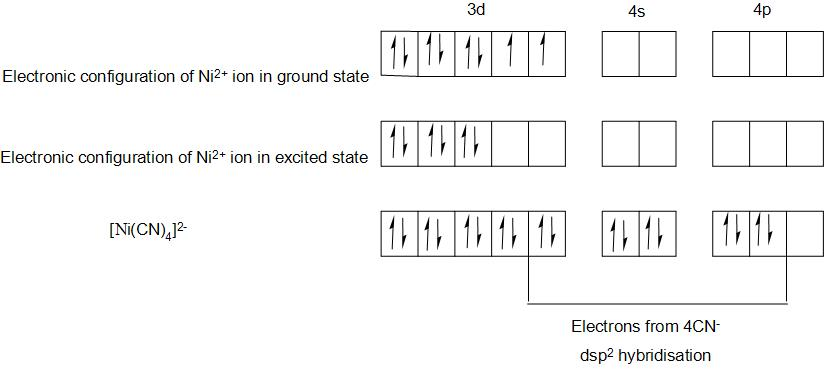
Which of the following shows \[ds{{p}^{2}}\] hybridisation and a square planar geometry?
A. $S{{F}_{6}}$
B. $Br{{F}_{5}}$
C. $PC{{l}_{5}}$
D. ${{\left[ Ni{{\left( CN \right)}_{4}} \right]}^{2-}}$
Answer
225k+ views
Hint: We have to find out the hybridisation, which means when different atomic orbitals are combined having different energies to give the equivalent orbitals. Here we will see the combination of one d orbital, one s orbital and two p orbitals to give the \[ds{{p}^{2}}\] hybridisation and square planar geometry.
Step by step solution:
- We will find the electronic configuration of Ni in the compound ${{\left[ Ni{{\left( CN \right)}_{4}} \right]}^{2-}}$,
- The electronic configuration of Ni is-$1{{s}^{2}}2{{s}^{2}}2{{p}^{6}}3{{s}^{2}}3{{p}^{6}}4{{s}^{2}}3{{d}^{8}}$
- And the electronic configuration of \[N{{i}^{2+}}\]will be-\[1{{s}^{2}}2{{s}^{2}}2{{p}^{6}}3{{s}^{2}}3{{p}^{6}}4{{s}^{0}}3{{d}^{8}}\]
- We can represent the valence bond representation as:

- Here we have filled the 8 electrons of \[N{{i}^{2+}}\] in 3d orbitals, the two unpaired electrons in the ground state of ion, will pair up in the excited state , due to the pairing energy supplied by the formation of strong bonds in the complex.
- This makes one of the 3d orbitals empty. By this we can see above that there are no unpaired electrons and hence the compound will be diamagnetic.
- Here we can see that 4 $C{{N}^{-}}$ ions will form a strong bond in the complex.
- And here the central metal ion undergoes \[ds{{p}^{2}}\] hybridisation and the complex ion takes square planar geometry.
- Therefore, we can conclude that the correct option is(d) that is ${{\left[ Ni{{\left( CN \right)}_{4}} \right]}^{2-}}$ shows \[ds{{p}^{2}}\] hybridisation and a square planar geometry.
- As we have seen from the above valence bond representation that there are no unpaired electrons present and hence it is diamagnetic, we can also say that it has zero magnetic moment.
Note:
- In presence of any strong field ligand like $C{{N}^{-}}$ , all the electrons are paired up, and in the presence of weak field ligands electrons are not paired up.
- We can calculate the magnetic moment, hybridisation, geometry, and magnetic nature from the valence bond representation.
Step by step solution:
- We will find the electronic configuration of Ni in the compound ${{\left[ Ni{{\left( CN \right)}_{4}} \right]}^{2-}}$,
- The electronic configuration of Ni is-$1{{s}^{2}}2{{s}^{2}}2{{p}^{6}}3{{s}^{2}}3{{p}^{6}}4{{s}^{2}}3{{d}^{8}}$
- And the electronic configuration of \[N{{i}^{2+}}\]will be-\[1{{s}^{2}}2{{s}^{2}}2{{p}^{6}}3{{s}^{2}}3{{p}^{6}}4{{s}^{0}}3{{d}^{8}}\]
- We can represent the valence bond representation as:

- Here we have filled the 8 electrons of \[N{{i}^{2+}}\] in 3d orbitals, the two unpaired electrons in the ground state of ion, will pair up in the excited state , due to the pairing energy supplied by the formation of strong bonds in the complex.
- This makes one of the 3d orbitals empty. By this we can see above that there are no unpaired electrons and hence the compound will be diamagnetic.
- Here we can see that 4 $C{{N}^{-}}$ ions will form a strong bond in the complex.
- And here the central metal ion undergoes \[ds{{p}^{2}}\] hybridisation and the complex ion takes square planar geometry.
- Therefore, we can conclude that the correct option is(d) that is ${{\left[ Ni{{\left( CN \right)}_{4}} \right]}^{2-}}$ shows \[ds{{p}^{2}}\] hybridisation and a square planar geometry.
- As we have seen from the above valence bond representation that there are no unpaired electrons present and hence it is diamagnetic, we can also say that it has zero magnetic moment.
Note:
- In presence of any strong field ligand like $C{{N}^{-}}$ , all the electrons are paired up, and in the presence of weak field ligands electrons are not paired up.
- We can calculate the magnetic moment, hybridisation, geometry, and magnetic nature from the valence bond representation.
Recently Updated Pages
JEE Main 2026 Session 1 Correction Window Started: Check Dates, Edit Link & Fees

JEE Isolation, Preparation and Properties of Non-metals Important Concepts and Tips for Exam Preparation

Isoelectronic Definition in Chemistry: Meaning, Examples & Trends

Ionisation Energy and Ionisation Potential Explained

Iodoform Reactions - Important Concepts and Tips for JEE

Introduction to Dimensions: Understanding the Basics

Trending doubts
JEE Main 2026: City Intimation Slip and Exam Dates Released, Application Form Closed, Syllabus & Eligibility

JEE Main 2026 Application Login: Direct Link, Registration, Form Fill, and Steps

Understanding the Angle of Deviation in a Prism

How to Convert a Galvanometer into an Ammeter or Voltmeter

Hybridisation in Chemistry – Concept, Types & Applications

Ideal and Non-Ideal Solutions Explained for Class 12 Chemistry

Other Pages
JEE Advanced Marks vs Ranks 2025: Understanding Category-wise Qualifying Marks and Previous Year Cut-offs

Thermodynamics Class 11 Chemistry Chapter 5 CBSE Notes - 2025-26

Organic Chemistry Some Basic Principles And Techniques Class 11 Chemistry Chapter 8 CBSE Notes - 2025-26

JEE Advanced 2026 - Exam Date (Released), Syllabus, Registration, Eligibility, Preparation, and More

JEE Advanced 2026 - Exam Date (Released), Syllabus, Registration, Eligibility, Preparation, and More

Hydrocarbons Class 11 Chemistry Chapter 9 CBSE Notes - 2025-26




